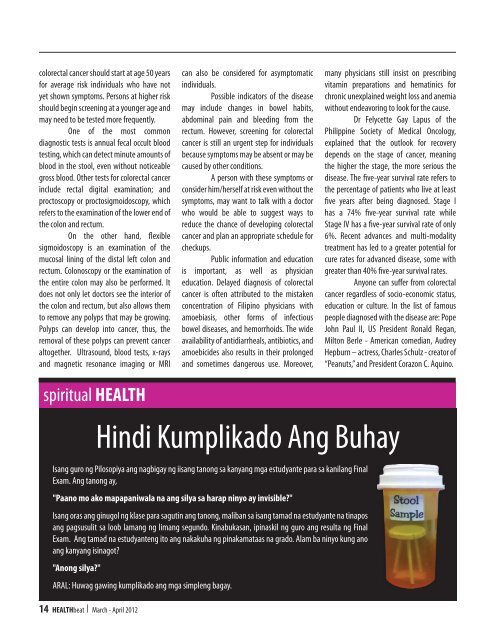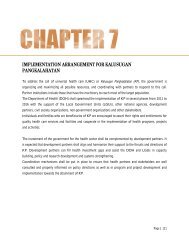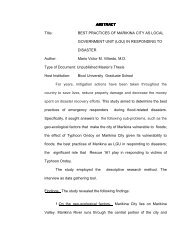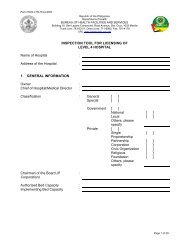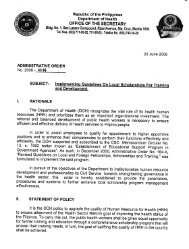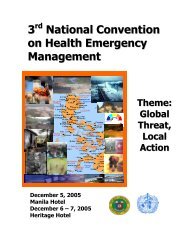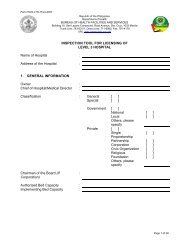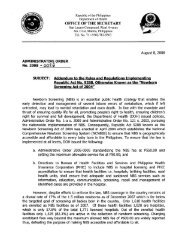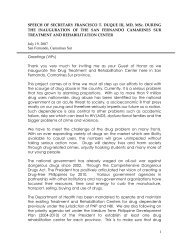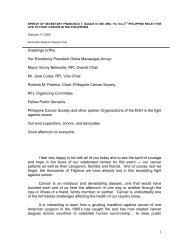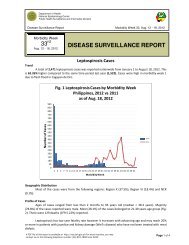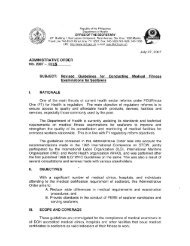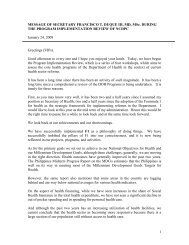Issue No. 69 - March - April 2012 - DOH
Issue No. 69 - March - April 2012 - DOH
Issue No. 69 - March - April 2012 - DOH
- No tags were found...
Create successful ePaper yourself
Turn your PDF publications into a flip-book with our unique Google optimized e-Paper software.
colorectal cancer should start at age 50 yearsfor average risk individuals who have notyet shown symptoms. Persons at higher riskshould begin screening at a younger age andmay need to be tested more frequently.One of the most commondiagnostic tests is annual fecal occult bloodtesting, which can detect minute amounts ofblood in the stool, even without noticeablegross blood. Other tests for colorectal cancerinclude rectal digital examination; andproctoscopy or proctosigmoidoscopy, whichrefers to the examination of the lower end ofthe colon and rectum.On the other hand, flexiblesigmoidoscopy is an examination of themucosal lining of the distal left colon andrectum. Colonoscopy or the examination ofthe entire colon may also be performed. Itdoes not only let doctors see the interior ofthe colon and rectum, but also allows themto remove any polyps that may be growing.Polyps can develop into cancer, thus, theremoval of these polyps can prevent canceraltogether. Ultrasound, blood tests, x-raysand magnetic resonance imaging or MRIspiritual HEALTHcan also be considered for asymptomaticindividuals.Possible indicators of the diseasemay include changes in bowel habits,abdominal pain and bleeding from therectum. However, screening for colorectalcancer is still an urgent step for individualsbecause symptoms may be absent or may becaused by other conditions.A person with these symptoms orconsider him/herself at risk even without thesymptoms, may want to talk with a doctorwho would be able to suggest ways toreduce the chance of developing colorectalcancer and plan an appropriate schedule forcheckups.Public information and educationis important, as well as physicianeducation. Delayed diagnosis of colorectalcancer is often attributed to the mistakenconcentration of Filipino physicians withamoebiasis, other forms of infectiousbowel diseases, and hemorrhoids. The wideavailability of antidiarrheals, antibiotics, andamoebicides also results in their prolongedand sometimes dangerous use. Moreover,many physicians still insist on prescribingvitamin preparations and hematinics forchronic unexplained weight loss and anemiawithout endeavoring to look for the cause.Dr Felycette Gay Lapus of thePhilippine Society of Medical Oncology,explained that the outlook for recoverydepends on the stage of cancer, meaningthe higher the stage, the more serious thedisease. The five-year survival rate refers tothe percentage of patients who live at leastfive years after being diagnosed. Stage Ihas a 74% five-year survival rate whileStage IV has a five-year survival rate of only6%. Recent advances and multi-modalitytreatment has led to a greater potential forcure rates for advanced disease, some withgreater than 40% five-year survival rates.Anyone can suffer from colorectalcancer regardless of socio-economic status,education or culture. In the list of famouspeople diagnosed with the disease are: PopeJohn Paul II, US President Ronald Regan,Milton Berle - American comedian, AudreyHepburn – actress, Charles Schulz - creator of“Peanuts,” and President Corazon C. Aquino.Hindi Kumplikado Ang BuhayIsang guro ng Pilosopiya ang nagbigay ng iisang tanong sa kanyang mga estudyante para sa kanilang FinalExam. Ang tanong ay,"Paano mo ako mapapaniwala na ang silya sa harap ninyo ay invisible?"Isang oras ang ginugol ng klase para sagutin ang tanong, maliban sa isang tamad na estudyante na tinaposang pagsusulit sa loob lamang ng limang segundo. Kinabukasan, ipinaskil ng guro ang resulta ng FinalExam. Ang tamad na estudyanteng ito ang nakakuha ng pinakamataas na grado. Alam ba ninyo kung anoang kanyang isinagot?"Anong silya?"ARAL: Huwag gawing kumplikado ang mga simpleng bagay.14 HEALTHbeat I <strong>March</strong> - <strong>April</strong> <strong>2012</strong>


